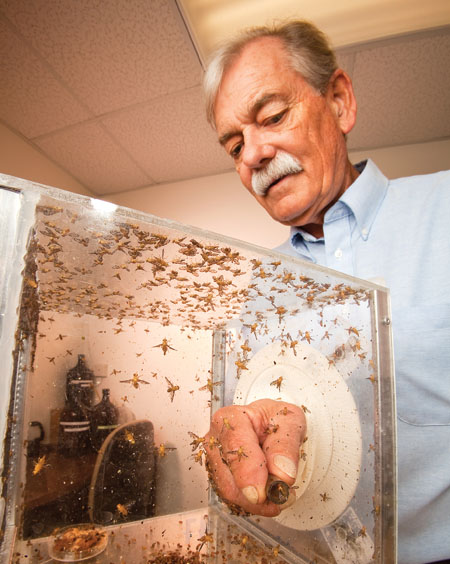Peter Teal works with several species of fruit flies. The Caribbean fruit fly has red eyes; the Mexican fruit fly has green. Both are fruit pests not wanted in the United States.
Photo by Stephen Ausmus, USDA-ars
In 1959, the very nasty flesh-invading screwworm fly was eradicated from Florida using a new kind of technology called SIT—Sterile Insect Technique.
Since then, the technology has been widely used. It is effective against fruit flies. It’s also being tested against malaria-carrying mosquitoes and against tsetse flies that cause sleeping sickness in Africa. Scientists are testing it now in Lake Superior, trying to reduce the population of sea lampreys, which suck the juices from desirable fish like trout.
American entomologists Raymond Bushland and Edward Knipling won the 1992 World Food Prize for pioneering the technique. Now, the technology has been further refined by work by Dr. Peter Teal, a U.S. Department of Agriculture physiologist and chemist in Gainesville, Florida, and his colleagues from Mexico, Argentina, and Austria. Their enhanced version is being used now to control the Mexican fruit fly in Mexico, hopefully keeping it out of California and Texas, and it’s expected to work against some other fruit flies as well. Several are invasive, quarantine species that would do great harm to citrus, peaches, and pears if established across the southern United States.
 “There are hundreds of kinds of fruit flies, and my work applies to many of them,” Teal said in an interview with Good Fruit Grower.
“There are hundreds of kinds of fruit flies, and my work applies to many of them,” Teal said in an interview with Good Fruit Grower.
How it works
The Sterile Insect Technique works this way on fruit flies:
Male insects are reared in captivity and exposed to radiation, and that induces many mutations that make them sterile. (It doesn’t make them radioactive.)
These sterile males are released into the wild population, where they compete with ordinary males for the attention of females.
Females that mate with sterile males lay eggs that won’t hatch. And since females mate only once, their choice of a sterile male prevents them having offspring to infect fruit.
One problem, Teal said, is that females are less likely to choose a sterile male. The process of irradiating males weakens them, so they don’t live as long or compete as lustily. “Radiation makes them weaker and less able to compete for wild females,” he said.
The ARS scientists and their cooperators discovered that they could make the sterile males stronger by feeding them hydrolyzed protein supplements. Then, Teal added a final touch.
He discovered that the hormone methoprene, when fed to sterile males along with the protein supplement, did two things. It made them more attractive to females, and it caused them to reach sexual maturity a week earlier. They were acting like macho young men among a group of boys, releasing more pheromone, attracting more females, and mating with them several days younger than their rivals. Since fruit flies normally have a short life span, and irradiated flies have even shorter lives, the treatment improves their competitiveness significantly, Teal said.
He found the natural insect hormone by testing the blood of male flies at various stages of their lives and found that levels of this juvenile hormone rose as sexual maturity increased. Methoprene is a stable analog that mimics that juvenile hormone.
These kinds of sex hormones are common in insects, Teal said. Methoprene is used to treat ponds and kill mosquito larvae by preventing them from becoming adults. Another similar compound is used as birth control for cockroaches.
His discovery is currently being used by MoscaFruit (the Inter-American Institute for Cooperation in Agriculture) in Sterile Insect Technique programs for the Mexican fruit fly and is being tested on other flies in South America and at a laboratory in Austria.
Mexico operates the sterile male release program, having a facility where millions of male fruit flies are reared, sterilized, and released in huge numbers to overwhelm an existing fruit fly population.
The SIT program is used by the Animal and Plant Health Inspection Service in areas of the United States where invasive insects are accidentally introduced. “Enough sterile males are released to flood the natural population,” Teal said. “Millions of sterile males may be released to subdue a small number of flies.”
APHIS also uses bait stations and aerial spraying when invasive species are found. Sterile Insect Technique is the next step. “It is much better than continual spraying,” Teal said.
The new feeding program—hydrolyzed amino acids and hormone in a paste—costs $13 per million flies released.

Leave A Comment